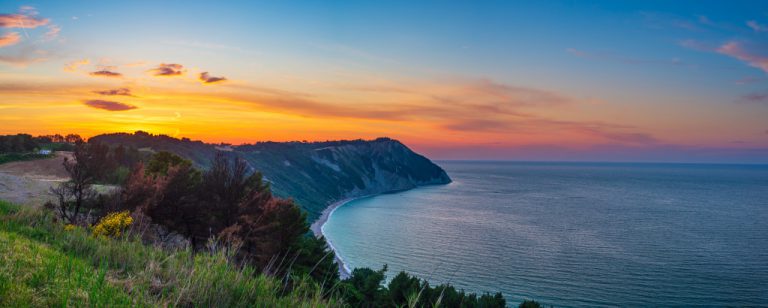The province of Ancona is located right in the heart of the Marche and has an incredible amount of beautiful places to visit and unique flavours to enjoy. Between the crystal clear sea, incredible landscapes and historical villages, this area will amaze you with its beauty and diversity!
Here are some places you must absolutely visit to fully enjoy your holiday in Le Marche, and to live this spectacular region to its fullest from your holiday home in Ancona:
1) The beaches of Senigallia
The town of Senigallia is undoubtedly one of the most sought-after seaside resorts in the province, due to its crystal-clear waters and soft sand, to the point that its beaches have been dubbed “velvet” beaches.
Here you can spend a day relaxing in the sun or practising water sports such as swimming, windsurfing, water-skiing or sup. The beaches are also well suited for families with children, as the seabed slopes gently and the little ones can enjoy themselves in the water without risk.
Senigallia’s promenade is full of seafood restaurants, bars and clubs that are located directly on the beach, making it possible to spend the whole day on the beach and then taste some fish specialities or enjoy an aperitivo while admiring the sea.
Senigallia, however, is not only about beaches: there are a number of others activities to enjoy, like strolling through the streets and admiring the beautiful churches and squares, such as the extensive Piazza Garibaldi and the Portici Ercolani. Not to be missed is a visit to the majestic Rocca Roveresca, one of the city’s most characteristic structures, whose foundations date back to Roman times, while the fortress has been built and enlarged many times over the course of time.
And, if you visit the city of Senigallia in the summer, you may come across a unique event: for ten days in the first week of August, the city hosts the Summer Jambouree, a festival of culture, concerts, performances and music from the 1950s. A stroll through the city will take you back to the years of the American economic boom, with vintage cars parked in the streets, polka-dot dresses and rock ‘n roll music playing throughout the town.
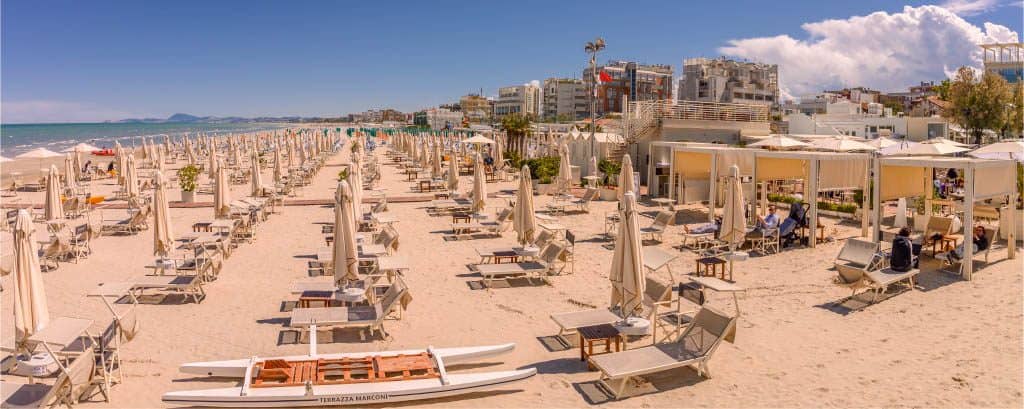
Senigallia beach
2) Town of Corinaldo
The small town of Corinaldo is situated on the top of a hill, in the inland area of Senigallia. This town is considered one of the most beautiful villages in Italy, and boasts the Orange Flag of the Italian Touring Club, and is also a European Tourist Destination of Excellence. Definitely a place worth visiting for a complete holiday in the Marche region!
The town is surrounded by perfectly preserved 15th-century walls and has unique attractions that cannot be missed, such as the famous Piaggia, where the Pozzo della Polenta (the polenta well) is also located.
The Piaggia is a staircase of a hundred steps situated right in the centre of the town, surrounded by classic medieval houses. At the centre of the Piaggia is the famous Pozzo della Polenta, the protagonist of a legend that later inspired the famous historical re-enactment “La Contesa del Pozzo della Polenta“, an event that takes place every year in July.
Speaking of polenta, why not stop for a nice plate of this typical dish, or taste the vincisgrassi, another absolute must of this region, before continuing your visit of Corinaldo? And it would be best to accompany it all with a glass of the typical wine of the region, such as the Verdicchio dei Castelli di Jesi.
There are then many other attractions to admire, such as the house of Scuretto, the protagonist of another traditional legend, or the beautiful sanctuary of Santa Maria Goretti.
Finally, absolutely not to miss is a walk along Corinaldo’s city walls, which embrace the entire historic centre of the village and are incredibly well preserved, dating back to the village’s medieval origins.
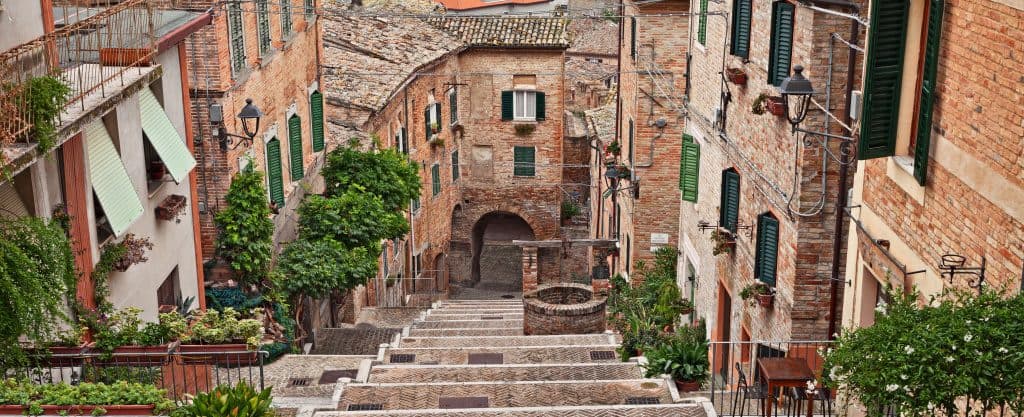
Corinaldo
3) Arcevia
A small municipality in the heart of the province of Ancona, Arcevia is located right in the centre of the Marche region, bordering the Gola della Rossa Mountains in the Umbria-Marches Apennines. Although not as well-known as many other territories in the Marche, this municipality has a rich history, with archaeological evidence dating back to the Palaeolithic period and a collection of 9 castles of medieval origin, where time seems to have stood still.
The town of Arcevia can be considered an excellent destination to visit in a day, walking through its charming streets and admiring monuments such as the beautiful Church-Museum of San Medardo, dating back to the 13th century and featuring works by various artists, such as Signorelli and Della Robbia.
Other points of interest are certainly the ancient fortifications, of which remains some towers and the entrance gates, and the Palazzo del Comune, one of the oldest in the region.
Finally, why not enjoy some peace and quiet after a day of sightseeing? The beautiful Garden of Leopardi offers an atmosphere of absolute relax, as well as a beautiful panorama, so you can end your visit of Arcevia on a high note.
4) Serra San Quirico
The pretty village of Serra San Quirico is located in the hinterland of Ancona, in the territory of the Parco della Gola della Rossa, right next to the Frasassi Caves. This makes the village a strategic point for all those visitor wishing to walk the paths of the Park or visit the countless natural attractions in the area.
However, Serra San Quirico is also definitely worth a visit and there are many interesting aspects to the town. First and foremost, the alleys of the “Copertelle” are certainly one of the most interesting aspects of this town: the “Copertelle” are covered alleys that are located above the city walls and that once served as walkways for the guards, who defended the city walls.
Also not to be missed is the Piazza della Libertà, located right in the heart of Serra San Quirico and in which there is a lovely 16th-century stone fountain.
5) Frasassi caves and the temple of the Valadier
The Frasassi caves are located in in the municipality of Genga, and are one of Italy’s best-known natural wonders. They are a series of underground caves connected by a single pathway, which were formed over millions of years, creating huge halls and striking sculptures of stalactites and stalagmites.
The Frasassi caves consist of several halls, the largest of which is the Abisso Ancona, which is so large that it could house the entire Milan Cathedral inside. Here, and in the rest of the caves, visitors can admire the limestone formations that have been created over the centuries, and which have been named after objects or animals, such as the slice of bacon, the giants, the small Niagara Falls and so on.
The caves, however, are not the only attraction worth visiting in this area: a short distance from them, in the small town of San Vittore in Genga, you can admire the large Romanesque Church of San Vittorie alle Chiuse and, right next door, the Speleo Paletnologico Museum.
And of course a visit to this area is not complete without admiring the hidden jewel of this territory: the Tempietto del Valadier. This small building is literally enclosed between three rock walls, while one side is open to the beautiful valley below. The building was commissioned in the 19th century by Pope Leo XII, and has a very unusual octagonal structure, with a lead dome typical of religious buildings of the time.
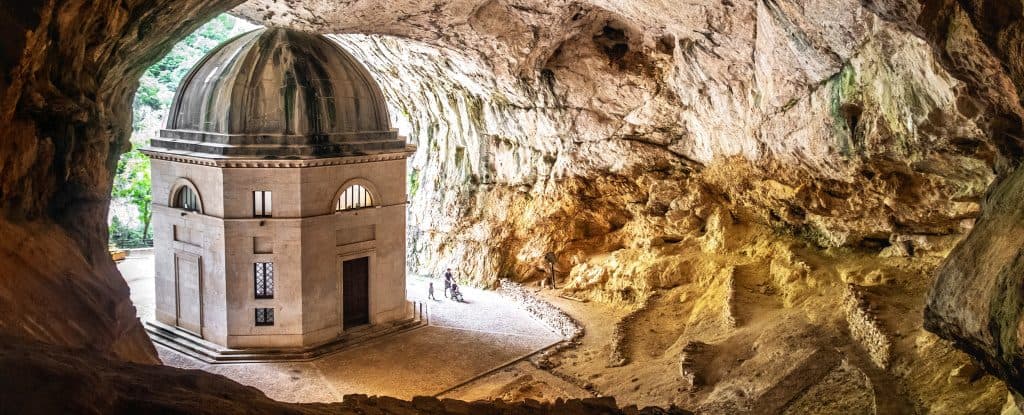
The temple of Valadier
6) Jesi
Jesi is a town in the province of Ancona, halfway between the sea and the mountains, and is one of the most tourist-friendly towns in the Marche region: it’s not too large, easy to get around on foot, and is also rich in art, culture and a has great culinary tradition.
Founded as a Roman colony, it is known as the birthplace of Frederick II of Swabia, after whom the city’s largest and best-known square, Piazza Federico II, is named. There is also an interactive museum completely dedicated to this great historical figure.
Another place to visit is Piazza Colocci, where the Palazzo della Signoria stands. This is certainly one of the best known public buildings in the Marche region, dating back to 1498.
Jesi is also a town rich of museums, where art lovers can choose between visiting numerous museums, like the Studio delle Arti della Stampa and the Pinacoteca Civica, located in Palazzo Pinetti.
After visiting the town of Jesi, it is possible to go and admire the area of the Castles of Vellesina, an area where a series of historical villages and castles dating back to the Middle Ages are located: among the most interesting villages are the Borgo di Castelpiano and that of Castelbellino, which stand out from the rest because of the excellent condition of its medieval buildings.
Finally, a visit to this territory is not complete without a taste of the delicious Verdicchio dei Castelli di Jesi, the typical wine of the area, of which there are many varieties and whose flavour is even better if accompanied by a tasting of the typical local dishes.
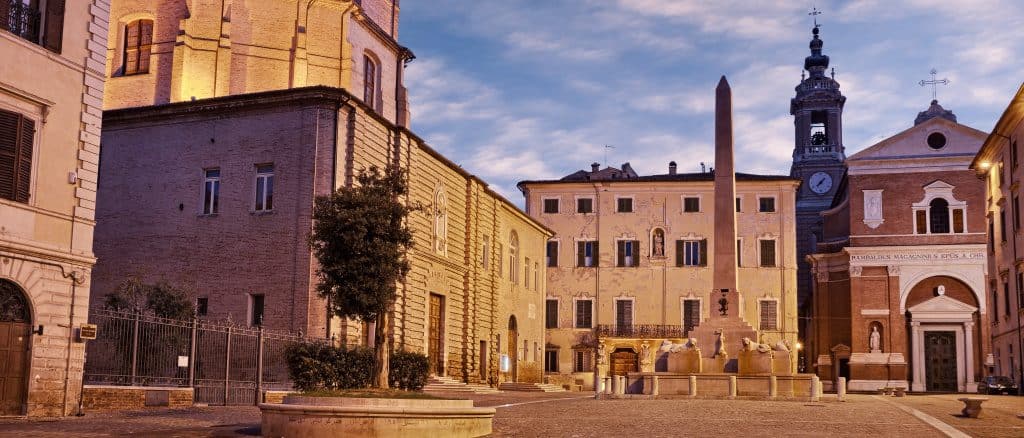
Piazza Federico II in Jesi
7) Morro d’Alba
Morro d’Alba is a small village between Jesi and Senigallia, and is one of the best known small towns in the area, known both for its beauty and, above all, for its renowned wine ‘Lacrima di Morro d’Alba’.
The centre of the village is surrounded by perfectly preserved medieval walls, with an eighteenth-century arched gateway acting as the entrance to the city centre. The structure has also undergone many changes over the years: in fact, with the introduction of gunpowder, the town walls evolved and it was felt necessary to make the walls sloping or ‘scarp’. Hence the name of the entire city walls, known in the village as “Scarpa“.
A walk along the Scarpa walkway is very interesting, allowing the visitors to walk in a circle around the centre of the town and admire the beautiful view of the surrounding hills.
Obviously, a visit to Morro d’Alba cannot be complete without a nice toast with the area’s signature wine, Lacrima di Morro d’Alba, a richly flavoured red.
8) Ancona
The city of Ancona is the capital of the entire Marche region, and a necessary stopover during a holiday in the Marche.
Ancona is best known for its tourist and commercial port, but the city also has many different attractions, from museums and historical monuments to beautiful areas where you can stroll.
The first place to visit in the town is the historical centre of, where there are many attractions: first and foremost, the beautiful Piazza del Plebiscito, known in the city as Piazza del Papa, in the centre of which stands the statue of Pope Clement VII. There are also numerous small restaurants, bars and other venues in the square, making this area a real meeting place for those who want to enjoy the social life.
Another point worth visiting is definitely the San Ciriaco Cathedral, one of the most interesting churches in the area. The church has in fact been built and modified numerous times, resulting in a mixture of Romanesque and Byzantine styles. The beauty of this church, however, lies not only in the building itself, but also in its location: this Cathedral is in fact situated in a panoramic position on the top of a hill, from where it is possible to admire the panorama of the entire city, going as far as the Adriatic.
However, Ancona is not only a city of monuments and churches: the city is also full of places where to stroll and relax. First and foremost is the famous Passetto, a beautiful district with a large park overlooking the sea, offering spectacular views.
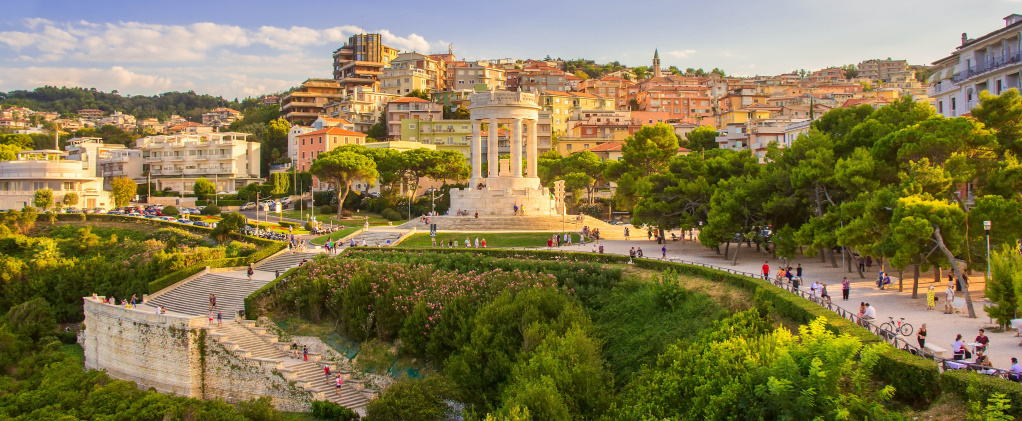
The Ancona passetto
9) The Conero Riviera
Along the coast of Le Marche, south of Ancona, we find the Conero Riviera, a spectacular stretch of land that is home to many of the region’s most beautiful beaches.
A crystal-clear sea, long beaches made of pebbles and sand, unspoilt coves, lush vegetation (for trekking enthusiasts, of course) and much more, is all that can be found in this beautiful area of Le Marche.
The beaches are the main attraction of the area, and there are many worthy of a visit: first of all, the stunning beaches of Portonovo, which combine the wild nature of the Mediterranean scrub and crystal-clear waters with well-equipped tourist facilities. It is one of the easiest Conero beaches to reach, thanks to the presence of car parks and wide paths.
Another beach not to be missed is Mezzavalle beach, a wild coastline that can only be accessed by sea or via a steep path. Its difficulty of access makes the beach often sparsely populated, and surrounded by the unspoilt nature of the area.
And, of course, it is impossible to talk about the Conero Riviera without mentioning its most famous beach, the Spiaggia delle Due Sorelle. Named for the two rocky outcrops that rise up between the crystal-clear waters, this splendid cove can only be reached by sea, by booking a boat tour or by private means, such as rafts and canoes.
One of the best activities to do in this area is to take a boat tour of the entire Riviera: there are many agencies that organise boat trips during the day or at sunset, offering numerous services such as lunch on the boat or an aperitivo.
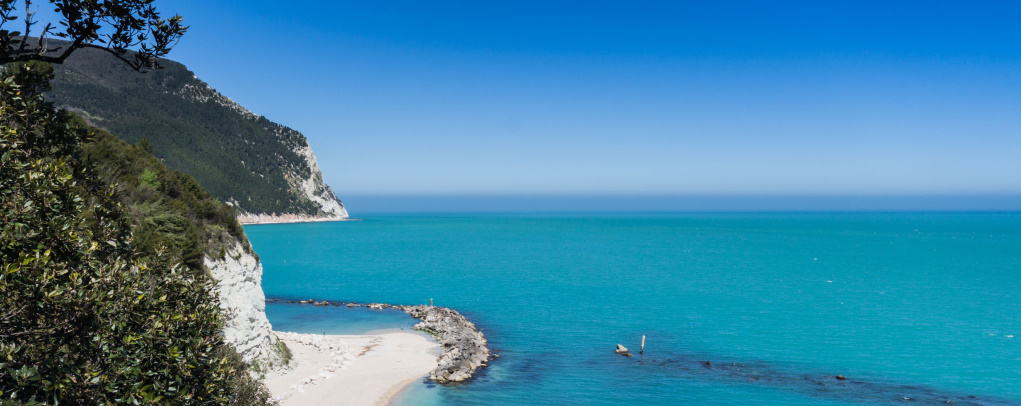
Spiaggia delle Due Sorelle, Conero
10) Town of Sirolo
Although the Conero is known for its crystal-clear beaches and unspoilt nature, it also has its fair share of man-made attractions: there are numerous beautiful small villages perched on the rocks overlooking the sea all along the Riviera.
None of these towns is as famous as the village of Sirolo, also known as the “Pearl of the Adriatic”. The small town is located right on the slopes of Monte Conero, about 125 metres above sea level and enjoys a breath-taking view of the sea.
The historic centre of Sirolo is an intricate labyrinth of narrow streets and alleyways, where you will find numerous bars, restaurants and shops and where you can stroll around and enjoy typical local specialities, such as pasta with moscioli sauce, moscioli gratinati or alla marinara or numerous other fish and seafood dishes.
Among the many attractions in Sirolo there are the Church of San Nicola di Bari – built in the neoclassical style-, the archaeological area of the Necropoli Picena and the beautiful central square of Sirolo, which overlooks the sea and offers one of the most breath-taking views of the town.
11) Fabriano
Fabriano is located in the Marche hinterland and is known throughout the region as the ‘City of Paper’: in fact, the city was once famous for its production of F4 paper sheets.
Nowadays we can find the very interesting Paper and Watermark Museum in the centre of the city. In the museum, you can follow the historical journey of paper, discover countless curiosities and, with especially fun for children, you can make a sheet of paper with your own hands, just as was done in the 13th century.
The city of Fabriano, however, is not only famous for paper; there are many other attractions in the city, such as the splendid museum of the historical piano and the beautiful streets of the city, which still retains much of its medieval structure.
Finally, how could we not mention the city’s countless gastronomic delights, such as the famous Fabriano salami and the less famous, but equally delicious, Fico-Miele salami? All these specialities – and much more – can be tasted in the city’s many small restaurants or bought directly from the Consorzio per la produzione e la tutela del Salame di Fabriano.
12) Loreto
The town of Loreto is undoubtedly considered one of the cultural and artistic jewels of the Marche region, not to mention one of the most important pilgrimage destinations in Italy, if not the whole of Europe.
Therefore, the best way to experience Loreto is to follow the route taken by hundreds of pilgrims before and walk the 330 steps of the Holy Staircase to the Basilica of the Holy House of Loreto.
The Basilica itself is a majestic structure, with massive fortifications, which inside contains one of the greatest treasures of Catholic spirituality, the Holy House of Nazareth. The stone walls of the house are richly decorated with bas-reliefs designed by the painter Bramante and are admired by thousands of worshippers every year.
This incredible building, however, is not the only artistic masterpiece in Loreto: from the famous works in the Museo Antico Tesoro della Santa Casa (such as those by Lorenzo Lotto, a well-known Italian painter) to the very special works of the Madonnari, street artists who reproduce some of the most famous religious paintings of all time in plaster on the floors of the Piazza della Madonna.
And if you want to visit Loreto, why not do it around December, in time to celebrate the traditional feast of the Fireworks of the Coming of Loreto? Tradition has it that on the night between the 9th and 10th December, the people of Loreto lit huge bonfires as a sign of gratitude to God. Even today this tradition is perpetuated in Loreto and all the surrounding countryside.
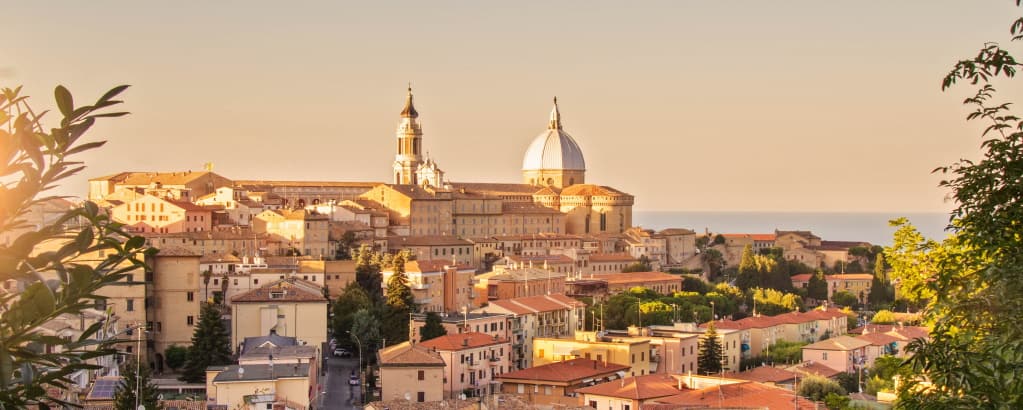
Loreto
